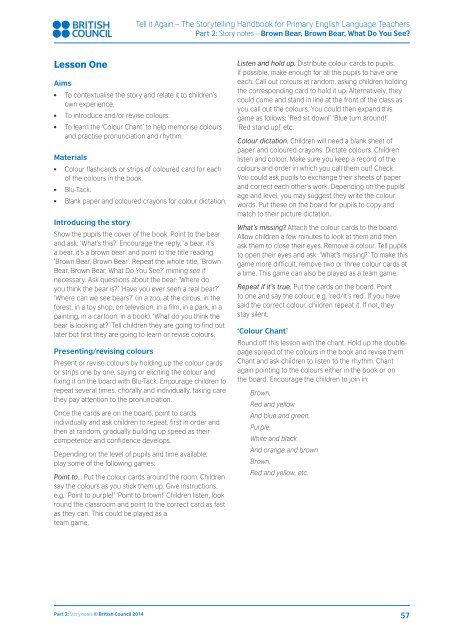1nW0gvB
1nW0gvB
1nW0gvB
Create successful ePaper yourself
Turn your PDF publications into a flip-book with our unique Google optimized e-Paper software.
Tell it Again – The Storytelling Handbook for Primary English Language Teachers<br />
Part 2: Story notes – Brown Bear, Brown Bear, What Do You See?<br />
Lesson One<br />
Aims<br />
●●<br />
●●<br />
●●<br />
To contextualise the story and relate it to children’s<br />
own experience.<br />
To introduce and/or revise colours.<br />
To learn the ‘Colour Chant’ to help memorise colours<br />
and practise pronunciation and rhythm.<br />
Materials<br />
●●<br />
●●<br />
●●<br />
Colour flashcards or strips of coloured card for each<br />
of the colours in the book.<br />
Blu-Tack.<br />
Blank paper and coloured crayons for colour dictation.<br />
Introducing the story<br />
Show the pupils the cover of the book. Point to the bear<br />
and ask: ‘What’s this?’ Encourage the reply, ‘a bear, it’s<br />
a bear, it’s a brown bear’ and point to the title reading<br />
‘Brown Bear, Brown Bear’. Repeat the whole title, ‘Brown<br />
Bear, Brown Bear, What Do You See?’ miming see if<br />
necessary. Ask questions about the bear: ‘Where do<br />
you think the bear is?’ ‘Have you ever seen a real bear?’<br />
‘Where can we see bears?’ (in a zoo, at the circus, in the<br />
forest, in a toy shop, on television, in a film, in a park, in a<br />
painting, in a cartoon, in a book). ‘What do you think the<br />
bear is looking at?’ Tell children they are going to find out<br />
later but first they are going to learn or revise colours.<br />
Presenting/revising colours<br />
Present or revise colours by holding up the colour cards<br />
or strips one by one, saying or eliciting the colour and<br />
fixing it on the board with Blu-Tack. Encourage children to<br />
repeat several times, chorally and individually, taking care<br />
they pay attention to the pronunciation.<br />
Once the cards are on the board, point to cards<br />
individually and ask children to repeat, first in order and<br />
then at random, gradually building up speed as their<br />
competence and confidence develops.<br />
Depending on the level of pupils and time available,<br />
play some of the following games:<br />
Point to… Put the colour cards around the room. Children<br />
say the colours as you stick them up. Give instructions,<br />
e.g. ‘Point to purple!’ ‘Point to brown!’ Children listen, look<br />
round the classroom and point to the correct card as fast<br />
as they can. This could be played as a<br />
team game.<br />
Listen and hold up. Distribute colour cards to pupils.<br />
If possible, make enough for all the pupils to have one<br />
each. Call out colours at random, asking children holding<br />
the corresponding card to hold it up. Alternatively, they<br />
could come and stand in line at the front of the class as<br />
you call out the colours. You could then expand this<br />
game as follows: ‘Red sit down!’ ‘Blue turn around!’<br />
‘Red stand up!’ etc.<br />
Colour dictation. Children will need a blank sheet of<br />
paper and coloured crayons. Dictate colours. Children<br />
listen and colour. Make sure you keep a record of the<br />
colours and order in which you call them out! Check.<br />
You could ask pupils to exchange their sheets of paper<br />
and correct each other’s work. Depending on the pupils’<br />
age and level, you may suggest they write the colour<br />
words. Put these on the board for pupils to copy and<br />
match to their picture dictation.<br />
What’s missing? Attach the colour cards to the board.<br />
Allow children a few minutes to look at them and then<br />
ask them to close their eyes. Remove a colour. Tell pupils<br />
to open their eyes and ask: ‘What’s missing?’ To make this<br />
game more difficult, remove two or three colour cards at<br />
a time. This game can also be played as a team game.<br />
Repeat if it’s true. Put the cards on the board. Point<br />
to one and say the colour, e.g. ‘red/It’s red’. If you have<br />
said the correct colour, children repeat it. If not, they<br />
stay silent.<br />
‘Colour Chant’<br />
Round off this lesson with the chant. Hold up the doublepage<br />
spread of the colours in the book and revise them.<br />
Chant and ask children to listen to the rhythm. Chant<br />
again pointing to the colours either in the book or on<br />
the board. Encourage the children to join in:<br />
Brown,<br />
Red and yellow<br />
And blue and green,<br />
Purple,<br />
White and black<br />
And orange and brown<br />
Brown,<br />
Red and yellow, etc.<br />
Part 2: Story notes © British Council 2014<br />
57


